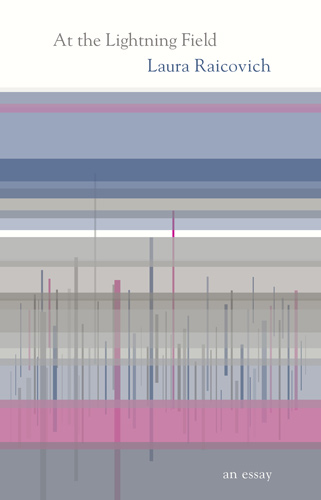At the Lightning Field
You may not have heard of conceptual artist Walter De Maria, but if you’re curious like me, you’ll want to know more about him and his career after reading Laura Raicovich’s book-length essay, At the Lightning Field.
You may not have heard of conceptual artist Walter De Maria, but if you’re curious like me, you’ll want to know more about him and his career after reading Laura Raicovich’s book-length essay, At the Lightning Field.
De Maria, a Californian, died in 2013. He’d been a musician in his earlier days, and later created sculptures now seen in various cities of the world. His creation, The Lightning Field, is a unique and humongous artwork in New Mexico’s desert that consists of hundreds of upright steel poles, each separated by a distance of 220 feet, all within a rectangular grid measuring one mile by one kilometer.
The installation is maintained and protected by the Dia Art Foundation, where author Raicovich worked for close to a decade. She wrote her essay after visiting the location many times and spending nights in a visitor’s cabin north of the grid. On a 2003 visit, she wrote these lines:
At The Lightning Field, I first relied on the regularities of
Newtonian principles,
relationships of measure, distance, and time.
I examined the grid and its individual components,
the poles:
four hundred poles demarcating the expansive grid,
four poles together creating a 440 square-foot unit.
I understood scale by walking the mile-by-kilometer
perimeter of The Lightning Field.
As you can see, Raicovich’s essay is written in an irregular style, often borrowing form from poetry. She also includes short passages from such notables as Gertrude Stein, Vladimir Nabokov, Anne Carson, Julio Cortázar, and Boris Pasternak. But the book focuses mostly on her personal experiences while visiting the site, bringing us there with images such as:
Sitting among the poles,
I leaned against one. [ . . . ] I sat, cross-legged, feeling the pole trace
my spine. It extended up some twenty feet over my head
as I was simultaneously
rooted to the ground and reaching
toward the sky through its pointed cone.
The wind made the pole tremble,
and my vertebrae echoed its hum
in sympathy with the steel.
Even more of interest to me were sections of the book about assembling the structure. Artist Terry Winters was a member of the original crew for four months. Raicovich attended a lecture where:
Winters talked about De Maria’s chosen site as the least
populated place in New Mexico, and noted its location
west of the continental divide.
He described lightning striking in the “empty” desert;
[ . . . ] about understanding how close the lightning felt
rather than how close it was.
To fill out the work crew, teenagers were hired from nearby Pie Town for $2.65 an hour. Since the entire crew was quite literally in the middle of the desert, “the group had to be inventive” with tools and supplies when the second shipment of two-inch diameter poles arrived damaged.
Though the poles varied in lengths from 15 to 27 feet to accommodate the uneven desert topography, “The tips of the rods are calibrated such that they could ‘evenly support an imaginary sheet of glass,’” according to De Maria’s writings. Raicovich adds that the crew wore white gloves while installing the poles.
She includes other notes De Maria composed, which gives readers a behind-the-scenes view:
The land is not the setting for the work but a part
of the work . . .
The sum of the facts does not constitute the work
or determine its esthetics . . .
The invisible is real . . .
Isolation is the essence of Land Art.
Raicovich writes that the installation “is not a magical place.” Yet she repeatedly expresses the idea that she wants to stay longer. It seems to me, therefore, that De Maria’s art form did hold magic for her.
She appears to sum up her visits in this way:
The Lightning Field evokes references to perfect geometries,
infinities, and the incremental expansion of the universe. The
artwork proposes a phenomenological responsibility:
digest the experience,
become physically, visually engaged.
Remember.
The cover design of At the Lightning Field features an interpretation of Walter De Maria’s work, but I really wished for photographs to be included. Look online to see numerous color and black and white images of this impressive art. Until you do, or until you actually see De Maria’s land art for yourself, reading Raicovich’s book makes it real and is sure to peak your interest in visiting this wonder of a project.





